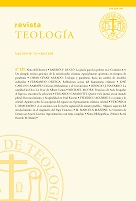Francis of Assisi: hosting the Leper, finding Salvation
Keywords:
Francis of Assisi, Hospitality, Theobald, Salvation, Mercy, LepersAbstract
This essay aims to show hospitality to the leper as a foundational experience in the life of Francis of Assisi. Located at the beginning of his conversion process -as conveyed in his Testament- the encounter and the practice of mercy with the lepers allowed the dissatisfied young man to break with his previous searches for meaning. At the same time, they revealed a new horizon of life remedied from his own frailties and the frail- ties of others which ask to be recognized, assumed and embraced. In the dynamism of giving and receiving, the most vulnerable -the leper- will be who will experience the most significant donation/revelation; indeed, in the wounded flesh of the leper, Fran- cis comes to «understand» what the incarnation is: the kenosis of God that manifests itself in a special way in the shattered flesh of humanity. Thus, the guest reveals some- thing that will change the meaning and destiny of Francis’s life: the next and final twenty years of his life will be indelibly sealed by that encounter. Going forward, the challenge that will be presented to the poor man of Assisi will be to commemorate this very first experience as a catalyst to be able to “fruitfully host” the wounds and anx- ieties that he will receive from his brothers in the Order, his infirm and wounded body and from an (apparently) absent God... in the silence of his final great night.Downloads
Download data is not yet available.
Downloads
Published
04/15/2020
How to Cite
Moore, M. (2020). Francis of Assisi: hosting the Leper, finding Salvation. Teología, 57(131), 79–97. Retrieved from https://e-revistas.uca.edu.ar/index.php/TEO/article/view/3040
Issue
Section
Articles
License
Copyright (c) 2020 Teología

This work is licensed under a Creative Commons Attribution-NonCommercial-ShareAlike 4.0 International License.














 Teología
Teología